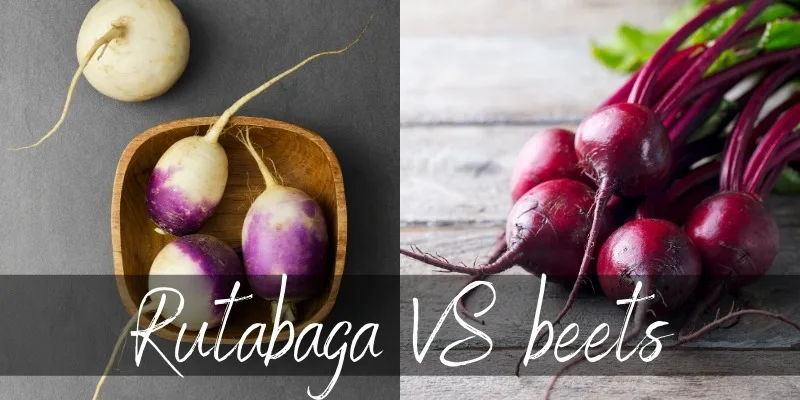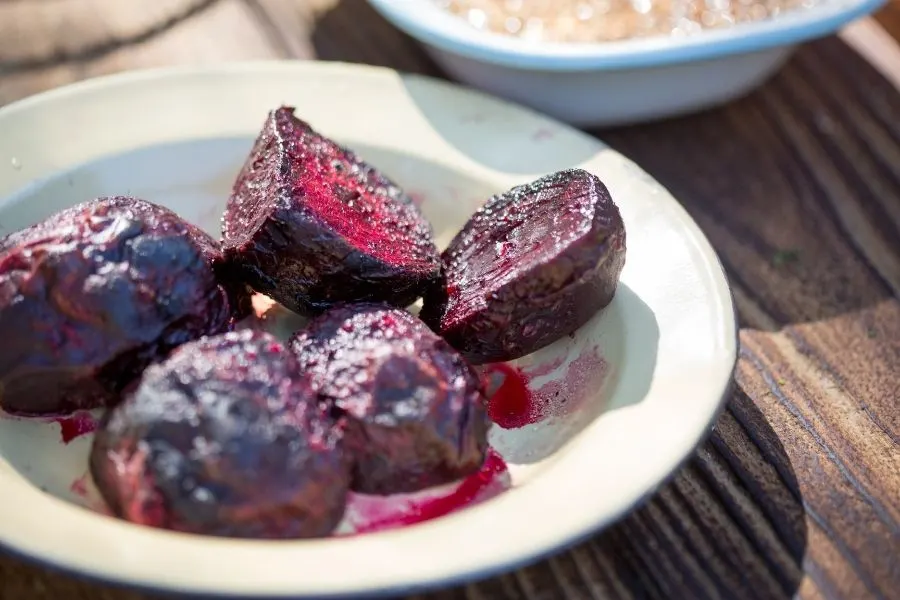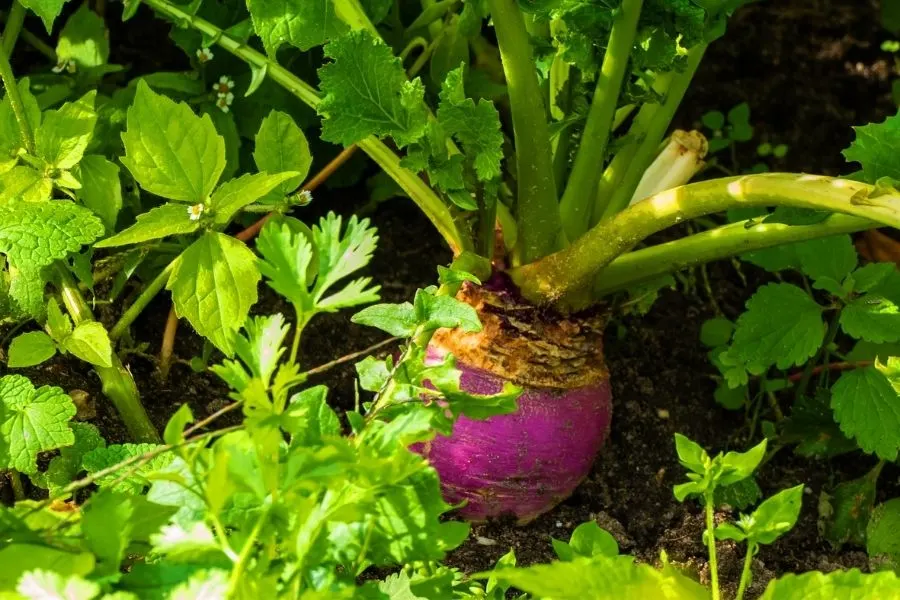Rutabaga and beets are two vegetables that you often see in the produce section, but rarely touch. To be fair, they can be very confusing for folks. Especially if we’re talking about rutabaga, which baffles most people. You’re not going to eat what you don’t know, are you ?
Fortunately there’s way to find out everything, and today we’re going to compare rutabagas to beets, and see how they’re best enjoyed. You might be surprised, they’re very versatile !

Rutabaga VS beets: what’s the difference?
Rutabaga is a hybrid between cabbage and turnips, light in color and mild. On the other hand, beets are bright red/ purple, with a deep earthy tone and a hint of sweetness. Both rutabaga and beets are root vegetables, however they each pack a punch of their own.
The main difference between the two is beets are sweeter, have less “crunch” than rutabaga and are closely related to Swiss chard. Rutabaga is closely related to cruciferous vegetables such as broccoli and Brussels sprouts.
According to ancient records, both beet and rutabaga were introduced somewhere around 4,000 years ago in Rome. Still, for such an old vegetable rutabaga often gets overlooked.
So let’s see how to enjoy each of these veggies, because they both bring something to the table.
Read also: How To Store Rutabaga
How to prepare rutabaga
Now that you know the basics of rutabaga, let’s explore the best preparation methods to bring out their flavor. The first step is to select the freshest rutabaga possible. To do this, you must know what to look for. They are in season from October to March. They peak during mid-winter.
While rutabagas and turnips are very similar, they are not the same. Rutabagas are grown in cool climates, large in size and purple/yellow in color. They should be firm to the touch and free of cuts/ nicks, approximately 4 inches in diameter.
It is also important to look at the greens attached to the vegetable. Rutabaga greens should be vibrant, fresh and smooth in texture. They are the perfect substitute during winter months when summer vegetables are out of season.
When eaten raw, rutabaga has a spicy, slightly bitter taste with a mildly sweet undertone. However, when rutabaga is cooked, it becomes savory and rich, very similar to a sweet potato. They should be peeled for preparation, never keep the skin on.
Once cut in half and sliced, the skins will peel off easily. Boiling the vegetable and using a food processor to turn it into “mashed potatoes” is a popular option. In fact, this vegetable is extremely versatile, it can even be cut into fries and placed in the air fryer. Simply slice and pair with a savory sauce for a healthy, guilt-free side dish.
How to prepare beets
Just like rutabaga, beets should be carefully selected at your local farmer’s market or grocery store. When your beets are high quality, the better your dish will taste. Beets should be firm to the touch.
Be sure to avoid soft spots on the surface as well as shriveled, wrinkled skin. It is best to select the same sized beets for equal cooking time. The beet greens should be dark, fresh and crisp.
Beets can be eaten raw when the outer is peeled with a vegetable peeler and the interior finely shredded over a salad. However, if you refer a softer, sweeter taste, beets can be roasted, steamed and baked.

When roasted, their earthy, sweet and savory flavor is apparent. Steaming beets is a quick method for enjoying these red/purple beauties. In fact, steaming can be a great way to add beets to a smoothie. This softens then and makes blending easier.
Baking beets is ideal for making chips. Beet chips can be easily made at home by cutting into “chip like” slices. In fact, beets can be added to baked goods such as brownies and muffins.
Rutabaga and beet leaves
Both rutabaga and beets have delicious greens attached to them. The preparation for both is similar to that of Swiss chard. You can use the tender, young leaves chopped in salads and soups, while the tougher and mature greens should be cooked to break down and become easier digested.
Rutabaga leaves can be substituted with green chard or spinach. The leaves of beets can be substituted with red/green chard. Beets and rutabaga are different in flavor and texture, but you can substitute their leaves for one another.
Growing rutabaga
Growing rutabaga yourself is the best way to ensure you receive the freshest vegetable possible. While it may not be ideal for everyone to grow this vegetable, if you have a garden and the right environment, give it a shot! Let’s take a look at what’s needed to grow this delectable vegetable.

To begin, you’ll need fertile, well-drained soil. Rutabagas need full sun and should reach maturity during fall frost. When weather is colder, the taste of rutabaga is enhanced as well as the texture.
The seeds should be sowed approximately 4 inches apart and 1/2 inch deep. The best time to plant seeds is early summer. Rutabagas require a lot of water and thrive in most soil. Adding mulch will ensure the soil stays cool and moist. Harvesting during late fall is the best time to maximize flavor.
Read Also:Rutabaga VS Jicama
Growing beets
Growing beets yourself will also intensify freshness and make for a delicious dish. If you can grow beets in your garden, give it a try! This sweet and vibrant vegetable won’t disappoint.
To begin, beet seeds should be sown 2 inches apart and 1/2 inch deep. They will need up to one week to germinate. This is the time it takes for the hard outer shell to soften. Always keeping soil moist during this time is important. Beets grow best in full sun. They need roughly 1″ of water per week.
One of the unique features of beets is their ability to be harvested at any time. For example, if you want baby beets, simply harvest at 1-2 inches in root diameter. Beets can withstand temperatures as low as 20F. It is important to make sure the roots do not freeze, a row cover can be used to protect the plant.
There are countless rutabaga and beet recipes to enjoy. Mashed rutabaga with olive oil, herbs, pepper and salt is a twist on the classic favorite. Roasted rutabaga is another easy dinner, chopped into cubes, with apple cider vinegar, parsley and olive oil.
As for beets, balsamic roast beets are a family favorite. Simply peel, chop, roast and add your balsamic glaze. Alternatively, you can make beet hummus, turning the ordinary dip into an exciting new flavor palette.
Whether you decide to eat them raw, boiled, baked or roasted, they are a simple delight. Eating rutabaga and beets is an easy and delicious way to spice up your life with a little color, richness and sweetness.

